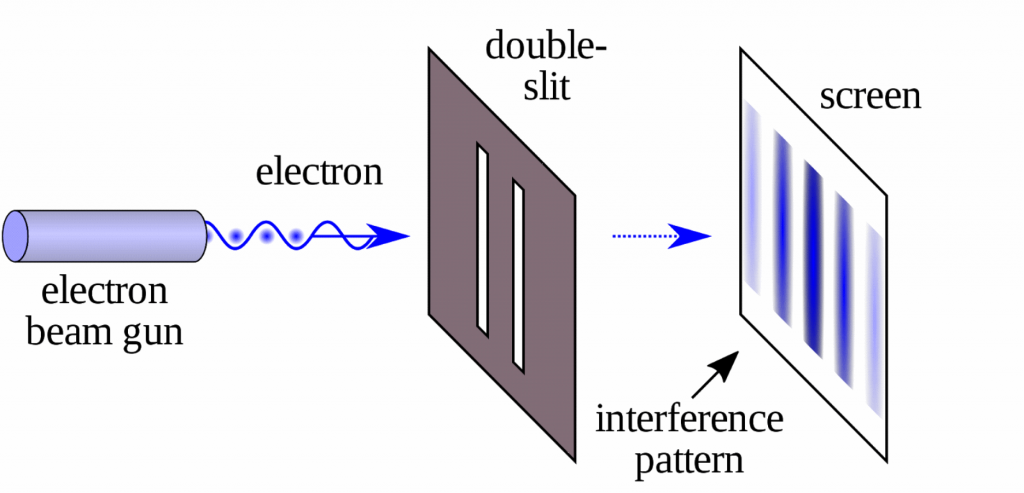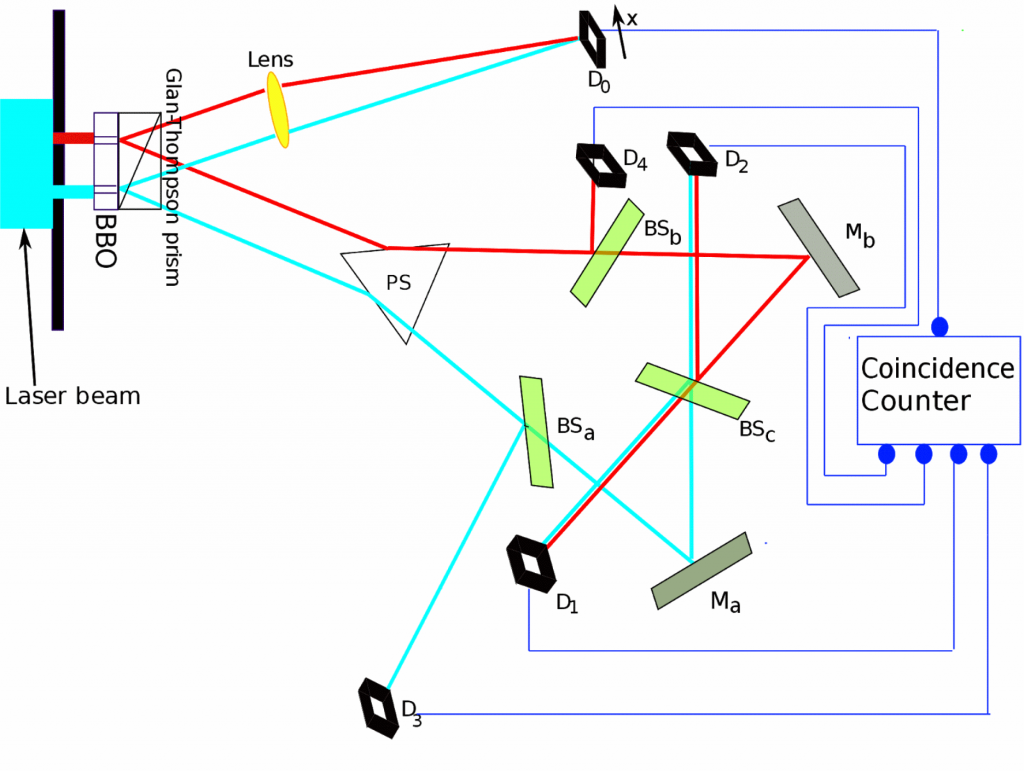Delayed choice quantum eraser experiment was first introduced by Yoon-Ho Kim, R. Yu, S. P. Kulik, Y. H. Shih and Martan O. Sculli. This experiment was conducted to investigate the behaviours of a photon. As light has a duality property (wave and particle) and it does not show its property together i.e. it shows one property at one time; so with the help of this advanced experiment, how does a particle behave in a quantum world was investigated. This experiment is an extended version of Young’s double slit experiment. So, we will first discuss about Young’s double slit experiment.

Young’s Double Slit Experiment:
This experiment was first performed by Thomas Young, hence the name of the experiment. He conducted this experiment to prove that the wave nature of light was correct as light was considered only as particles at that time. At first this experiment was conducted by using only one slit.
When a coherent light was injected through the single slit it produced only one line as it should be. It is true for both our world and quantum world. As there was only one slit, the photon particles of light travelled through the single slit and made a single line. But what about having two slits?
Well, in this case there will be some differences for our bigger world and the quantum world. Imagine, you have a ball in your hand and in front of you there is a wall having two slits. If you throw the ball to the wall then there will be three possibilities; the ball will pass through the left slit, the ball will pass through the right slit or it will bounce back by colliding with the wall. Hence, if we place a screen behind the wall, the number of passing balls will make two lines in the screen. This is obvious, because there was only two slits and that is why the balls would make only two lines.
Now, let us come back to the quantum world. In this case we will use a light source instead of balls. But before conducting the experiment we have to consider the following conditions:
⦁ The two sources should be coherent.
⦁ The amplitudes of the two sources should be or nearly equal.
⦁ The distance between the two slits should be as close as possible to make the fringe patterns clearly visible.
⦁ The two lights should be narrow; otherwise they will superimpose with each other in space.
Simply, we can use one source of light before a wall, having two slits. After that arrangement the light beam is projected through the two slits. Now, will they again form two lines as before? Well No, they will produce interference patterns having bright and dark fringes instead of two lines but why? The light has source particle which is known as photon. If they are particles then why are they showing interference pattern? This happens only in case of waves. When a wave passes through two slits it creates an interference pattern. Because, in the screen where the top and bottom of the waves meet, they cancel out each other and produce dark fringes and where the top of the waves meet together they produce bright fringes.
This experiment shocked the whole world as it exposed the wave nature of light, i.e. light has dual property. But in that case the scientists claimed that may be the photon particles collided with each other forming the sea of waves. After considering this idea the scientists decided to project only one particle at one time so that they do not collide with each other. By using an electron gun, the scientists fired one electron in the two slits. But the result was very astonishing. It produced interference pattern again like before. It seemed that the electron converted itself into wave before entering the two slits and created interference pattern by interfering with itself.
It was too strange to handle. Also, the scientists could not detect through which slits the electron passed; either of the two slits or both of them! So, they put a detector before the two slits to detect through which slit/slits the electrons passed. After this arrangement the electron was fired again and the result was shocking. In this case, the particle produced only two lines instead of interference pattern in the screen.
What? How can a particle act like this? This was weird and interesting, because it revealed that the particles act in a very weird manner. When we do not observe them they act like wave and when we observe them they act like particle. So, to study it in at an advance level, this experiment was further improved which was called as Delayed Choice Quantum Eraser Experiment.
Delayed Choice Quantum Eraser Experiment:
As mentioned earlier, this is an extended version of double slit experiment. This experiment was conducted to understand the behaviour of the particles but it actually explains that time travelling in quantum world is possible. Yes, I am not kidding. In this experiment, an electron travels through time to past and changes the resultant outcome.
This experiment is based on Wheeler’s delayed choice experiment. Actually it was first proposed by John Archibald Wheeler, hence the name. The photon particles ‘choose’ one possible state whether it will behave as particle or wave. The quantum particles actually remain in superposition state and after observing them they choose one possible state. That is why the name of the experiment was taken as Delayed Choice experiment.
In Wheeler’s delayed choice experiment some changes were made. In this case, the detector was placed in front of the impact screen instead of the two slits so that the electron cannot change its state. Note that, the electron can only change its state when any detectors detect it. After this arrangement the light beam was injected through the two slits. But here also the result was shocking. It showed particle nature by producing two lines instead of interference pattern. That means, the electron came to know that something was detecting it but how? The detector was placed in front of the screen, not in front of the two slits! This is possible only in that case, when the electron travels to past and changes its state according to the observer.

That is why, the experiment was moved to further advanced level to understand the behaviour of the particles and was named as Delayed Choice Quantum Eraser Experiment. In this experiment, a nonlinear optical crystal was used behind the two slits so that it can create a pair of entangled particles. Entangled particles can also be referred to as twin particles of a particle which spins in opposite direction to each other. The arrangement was such that, if the particle enters through the red slit (shown in figure) it creates an entangled particle and one of the entangled particles is sent to the screen and the other one is sent to the detector D4. Like that when the particle enters through the blue slit, one of its entangled particles is sent to the screen and the other one is sent to the detector D3.
Thus, through this arrangement we could know through which slit/slits the electron passed. Because, if during the experiment D4 and D3 detect the electron then we can be ensure that the electron passed through the red slit and blue slit respectively.
In this experiment the arrangement was such that both the entangled particle will reach the screen before the detectors D3 and D4 detects the two entangled particles. But after injecting the electron, it again showed the particle nature by producing only two lines. It seemed that the other entangled particle which was detected by the detector, informed the first entangled particle that there was an observer and therefore they should show particle nature. The scientists made some changes with this experiment by adding some half silvered mirrors which are represented in the above figure with green colour.
These half silvered mirror gives a 50% chance of reflection or transmission of electrons. There was an additional change made by the scientists. A quantum eraser was used at the end of the arrangement. That means, now we have two additional detectors – D1 and D2.
With this experiment we could not identify through which slits the electron passed. In this case after injection of the electron, it showed wave nature by producing an interference pattern instead of two lines. It was really weird, because the second entangled particle (headed towards the detector) informed the first entangled particle (headed towards the screen) that there was not any observer observing them though the first entangled particle impacted first to the screen before the second one headed to the detector. That means, the second one travels to past and inform the first one about the condition of the observer.
This experiment proved that quantum physics is really weird and interesting. Because it studies the whole universe at the quantum level and things are weird in there. The above experiment may be explained by Pilot wave theory which is also called as de Broglie-Bohm theory. This theory is a hidden variable theory. Hidden variable is nothing but the position and momentum of the particles. We cannot identify a precise variable of these hidden variables which is called quantum superposition. The particles always remain in quantum superposition state until some observer observes it. After observing them the wave function gets collapsed and we get a probable result among many probabilities.

About Author: Mostafa M. Hassan has a total work experience of 10 months in STEM Learning. He is a Program Implementation Associate.

